With the November election coming up, political speeches are happening a lot, with plenty of different styles and tactics being used. But what makes a speech truly resonate with voters? One crucial factor is readability—the ease with which the language can be understood by the average listener.
Studies have shown that as the literacy rates in a county decline, voter participation also tends to decrease, and therefore understanding readability is crucial for candidates and voters alike. This is because it affects how well political messages are communicated and received, shaping voter engagement and potentially influencing election outcomes!
Originality.ai wanted to highlight the reading age of US political speeches and so we decided to dive deeper into what exactly each party and candidate is saying, identifying which candidates use the lowest reading age, which ones alter the reading age based on where their speech is, and how political speeches have changed in recent times.
We created this study to show how language may be able to influence voter turnout and the political parties that voters resonate with the most based on average American reading age.
Before we dive in, let’s quickly address what we mean when we use the term ‘readability’.
In this instance, readability refers to how easily a piece of text can be understood by a reader, taking into account factors like sentence length, word complexity, and overall structure.
There isn’t a specific definition for the term readability, but in this article we will measure it using some of the most commonly used formulas, such as the Flesch-Kincaid Grade Level, which estimates the education level required to comprehend text.
Low readability could mean that language is more accessible for the average voter, which means they’ll understand the stance and policies used by specific candidates. The easier the language is to understand the more likely a citizen may choose to vote a certain way or connect with a candidate.
We chose these types of formulas for this study to ensure that the information was analyzed impartially, providing you with a completely unbiased look at political speech readability.
To analyze the readability of political speeches, we gathered text files containing speeches by candidate and party from 2024 back to hundreds of years, ensuring each file was labeled by date and location.
We then used the readability methods Flesch-Kincaid Grade Level and Gunning Fog Index to establish the readability for each speech, which allowed us to estimate the U.S. school grade required to understand what was being said.
We then sorted the data by date to establish a trend timeline. We’ve also provided a more detailed breakdown at the bottom of the article.
Readability allows voters to easily understand the policies promoted by each candidate. We first analyzed the readability of Donald Trump's speeches between 2019 and 2024 to find out how easy he is to understand.
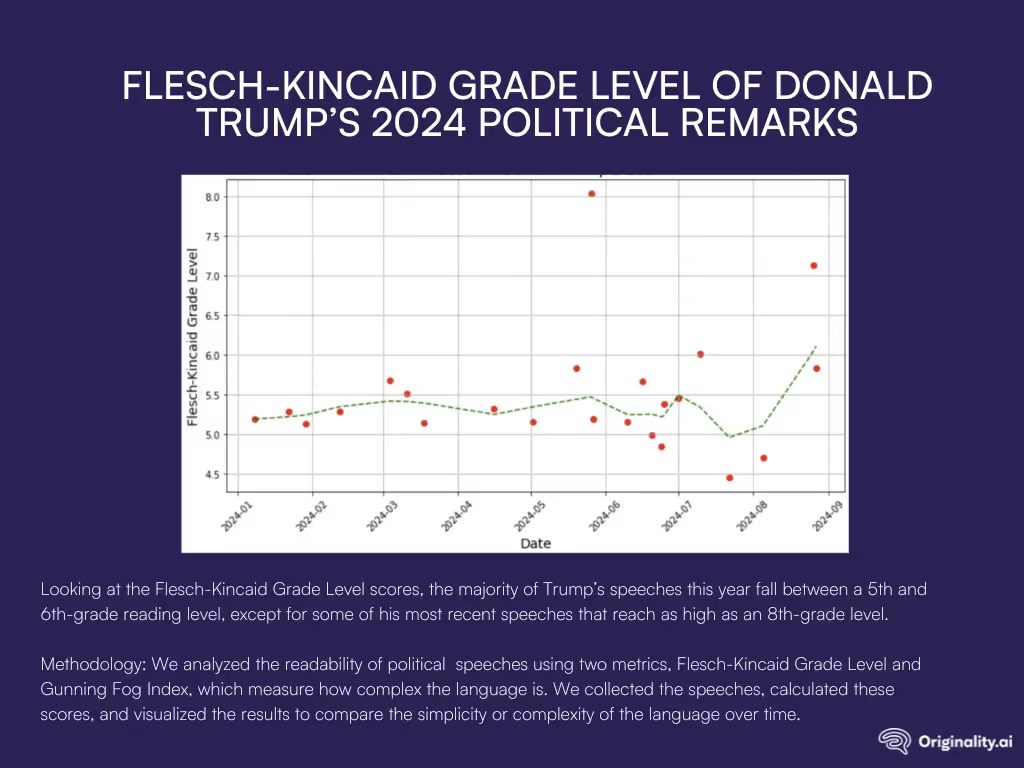
Looking at the Flesch-Kincaid Grade Level scores above, the majority of Trump’s speeches this year fall between a 5th and 6th-grade reading level, except for some of his most recent speeches that reach as high as an 8th-grade level.
While this might seem like a negative, it actually indicates that the speeches are designed to be easily understood by a broad audience, especially given that the average American reading age is a 6th Grade reading age. This ensures that as many Republicans or undecided voters can comprehend the points that he is making.
By using straightforward language and relatively simple sentence structures, Trump ensures that his speeches are suitable for younger audiences or those with less formal education, allowing him to reach larger volumes of people with his messaging.
But let’s quickly circle back to those speeches that contain a higher readability score. These speeches show slightly higher complexity, likely incorporating more formal language or denser sentence structures.
These higher scores suggest that certain speeches may have been tailored for more specific or formal settings, requiring more attention and comprehension. In fact, this data point was for remarks Trump made at the Libertarian Party Convention in May, which spoke to a well educated group in a formal setting.
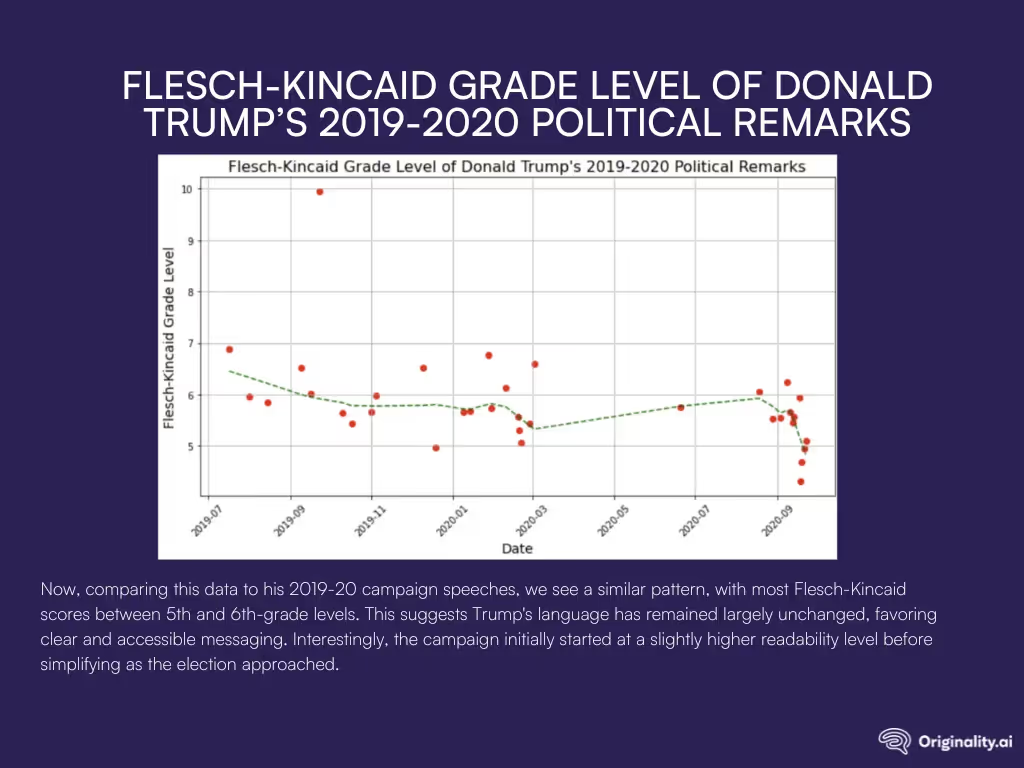
Now let’s compare that data to his political speeches from his 2019-20 campaign run. Using the same Flesch-Kincaid Grade Level scoring system, we can see a pattern similar to his 2024 speeches, with most scores falling between the 5th and 6th-grade levels.
These metrics show that his language has not changed very much since his most recent campaign run, focusing on straightforward, accessible language.
Interestingly, the data would suggest that Trump and his team actually started the campaign at a slightly higher readability level on average, before lowering it and making his messaging more clear in the lead up to the vote.
Comparing the two, the overall complexity remained low in both periods. The slight decrease in average grade level in 2024 from 2019-20 could reflect a strategy to make the speeches even easier to understand as the campaign progressed.
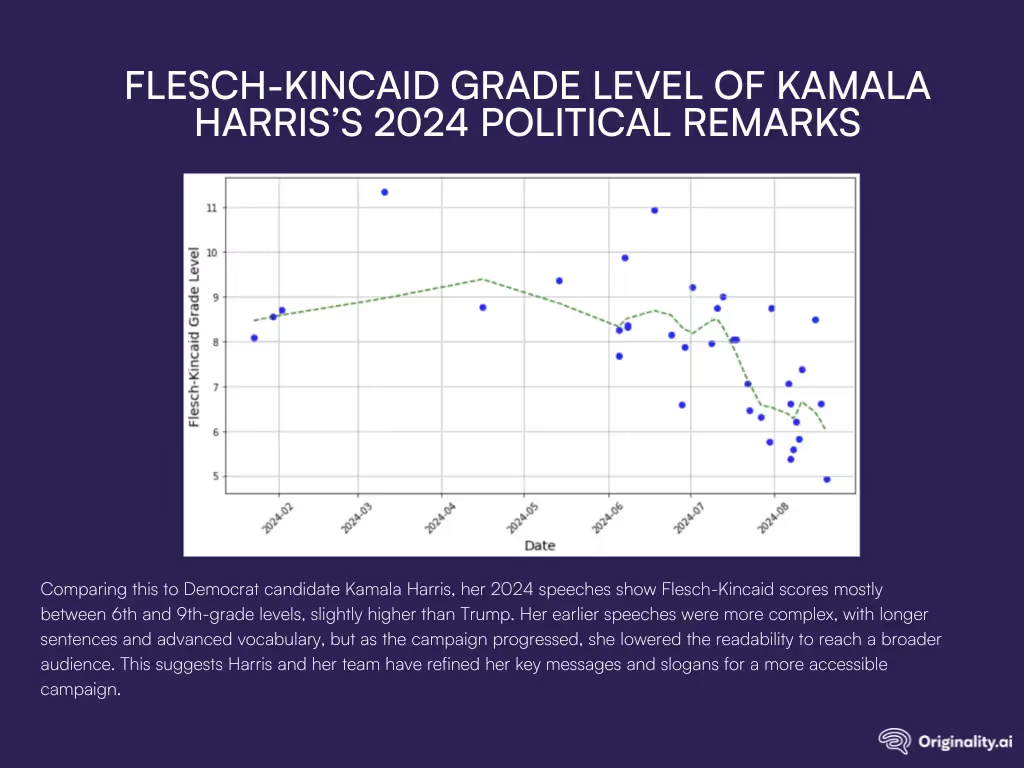
Next, let’s compare Trump’s results to those of the Democratic candidate, Kamala Harris. The Flesch-Kincaid Grade Level scores for select Kamala Harris' 2024 remarks show a range of readability levels, with most speeches falling between the 6th and 9th-grade levels.
That’s slightly higher than Trump on average (Trump has a 5th and 6th-grade level) , with several of her speeches reflecting a higher complexity, especially during the start of her campaign. This higher readability would likely mean longer sentences and more advanced vocabulary, which would require a higher reading comprehension from the audience.
It should come as no surprise that Harris’s readability has recently significantly dropped since announcing her run for president in July 2024, ensuring her message is heard and understood by as many Americans as possible.

How do those figures compare to presidential candidates of years gone by?
The figure above was generated by a paper published in 2020 on the readability of congressional speeches in the last 150 years.
As you can see from the results, for many years there was little separating the two parties, with Democratic speeches typically having a slightly higher readability index compared to Republican speeches.
However, that difference became much more pronounced from the mid-90s to the 2010s, and the gap between the two parties has actually gone in the complete opposite direction since
Moving away from the practicality of the words used, let’s now take a look at the sentiment analysis. This data highlights how often each candidate uses words associated with positivity and negativity.
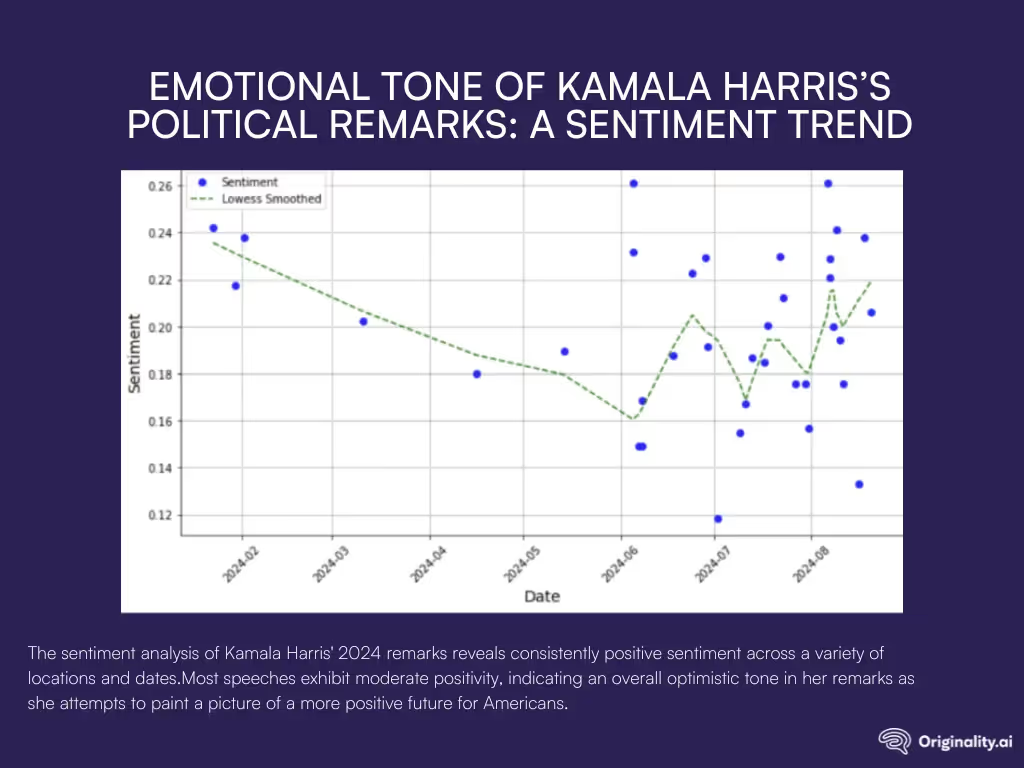
The sentiment analysis of Kamala Harris' 2024 remarks reveals consistently positive sentiment across a variety of locations and dates.
Most speeches exhibit moderate positivity, indicating an overall optimistic tone in her remarks as she attempts to paint a picture of a more positive and fruitful future for her fellow Americans.
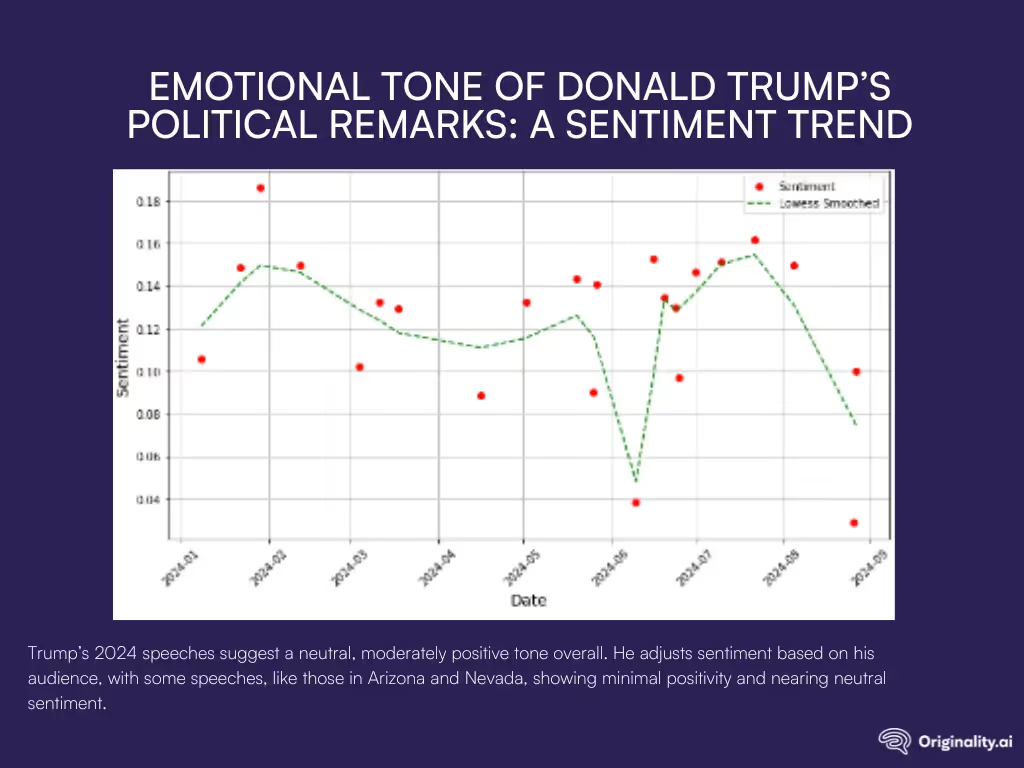
In contrast, Trump’s 2024 remarks suggest his campaign has opted for a more neutral tone. Within that, many speeches fall within a narrow range of moderate positivity, indicating a generally consistent, moderately positive tone throughout the campaign.
Trump has also shown that he will amend the sentiment of his speeches depending on his audience. At the lower end of the spectrum, speeches like the one delivered at the Southern Border, Arizona and Sunset Park, Nevada, reflect minimal positivity, bordering on neutral sentiment.
Overall, the data above shows that Kamala is consistently more positive than Trump's in their 2024 campaigns.
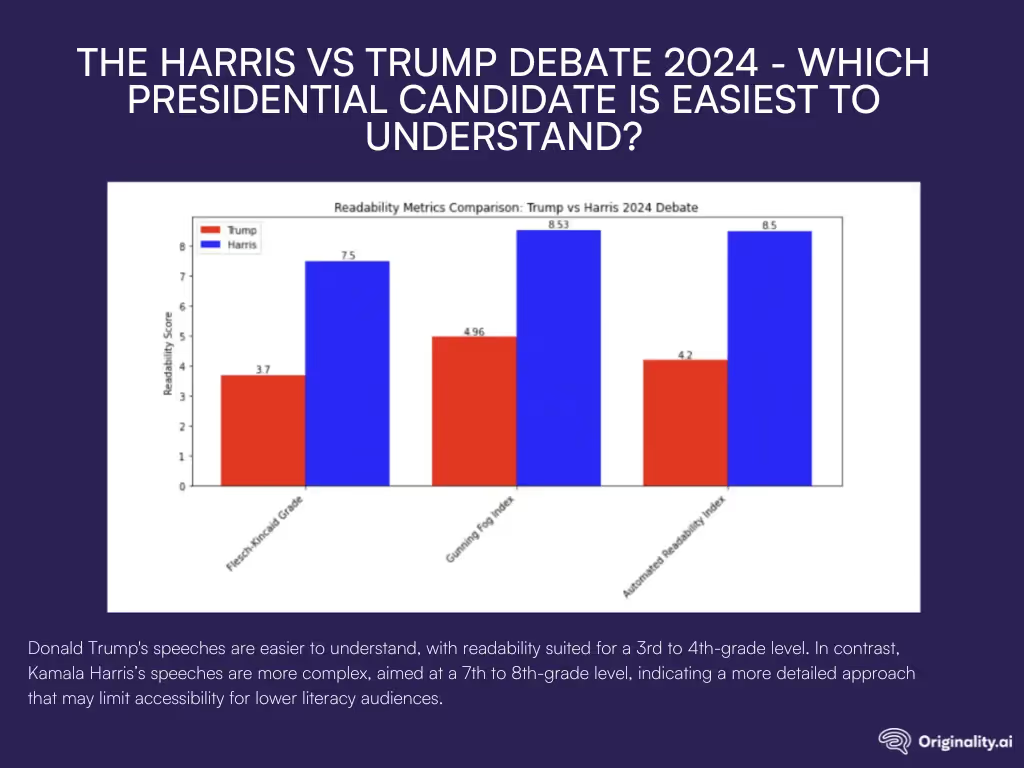
Finally, let’s take a look at some word frequency comparison between the two candidates. The readability analysis for both Donald Trump and Kamala Harris shows distinct differences in the complexity of their language during the debate.
Donald Trump's readability scores indicate that his speech is easier to understand. Trump's speech falls into the "easy to read" category, suggesting it could be understood by someone with a third to fourth-grade reading level.
In contrast, Kamala Harris’s readability scores suggest that her speech was more complex. Harris’s speech is suitable for someone at a seventh to eighth-grade reading level, which could suggest a more policy-detailed approach, but it may also limit accessibility to audiences with lower literacy levels.
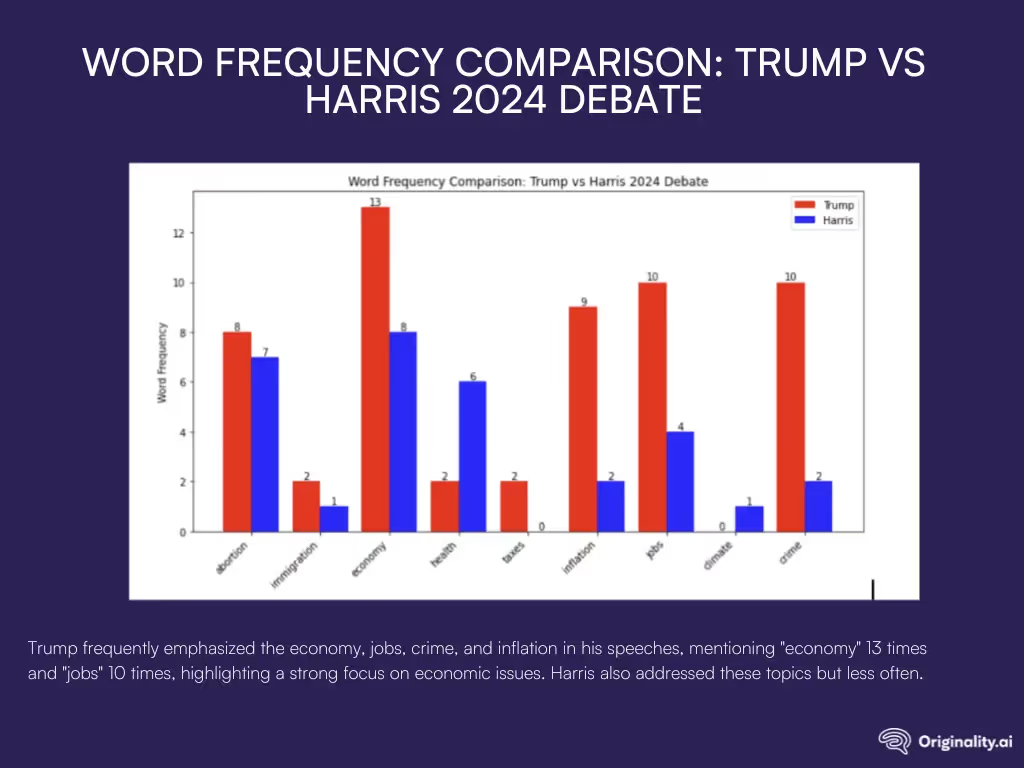
Looking specifically at how many times certain words were used, Trump emphasized topics like the economy, jobs, crime, and inflation, all of which appeared frequently in his statements. His higher mention of terms like "economy" (13 times) and "jobs" (10 times) suggests a strong focus on economic issues and employment. Harris also touches on these topics but with less frequency.
Notably, Trump mentions "abortion" 8 times, which is slightly more frequently than Harris (7 times). This indicates that both candidates consider this topic crucial, but Trump's higher frequency might suggest a more aggressive approach, although the difference is minimal.
Harris, on the other hand, appears to place more emphasis on "health," mentioning it 6 times compared to Trump's 2 mentions.
This signals a possible prioritization of healthcare issues. Both candidates mention "climate" and "taxes" infrequently, suggesting these may have been less central topics in this particular debate, which likely reflects what their teams are seeing as the most important issues to their voters.
We also created a word cloud from each candidate, to help provide another visual representation of the most prominent words that Harris and Trump used in the recent presidential debate.
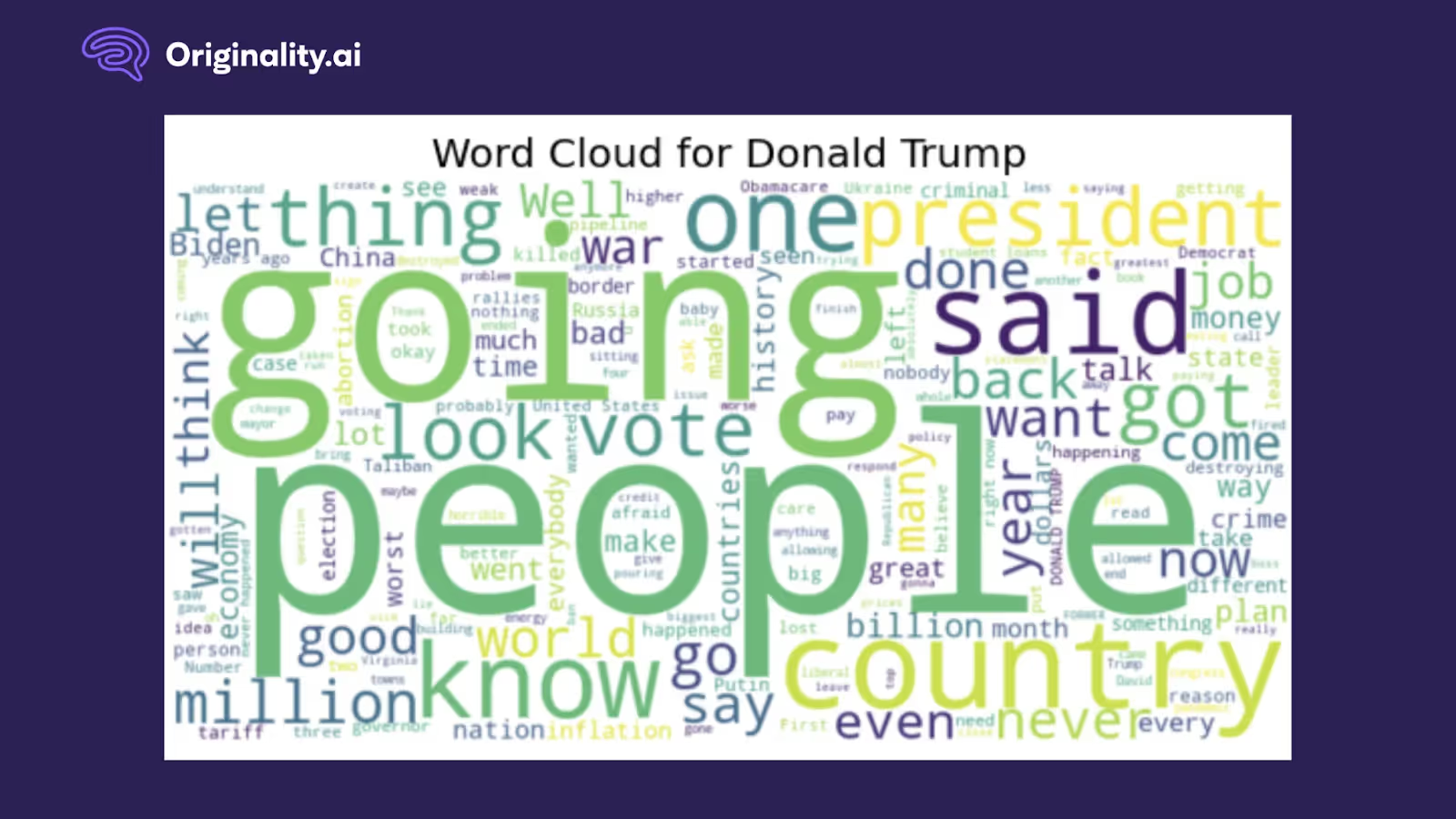
One of the most frequently used words by Trump is the word “people” which suggests two things. One, he often refers to himself as the voice of the people, explaining that “people have it much worse now than when I was president”. Two, it also shows how frequently he discusses immigration, referring to “people coming across the border.”
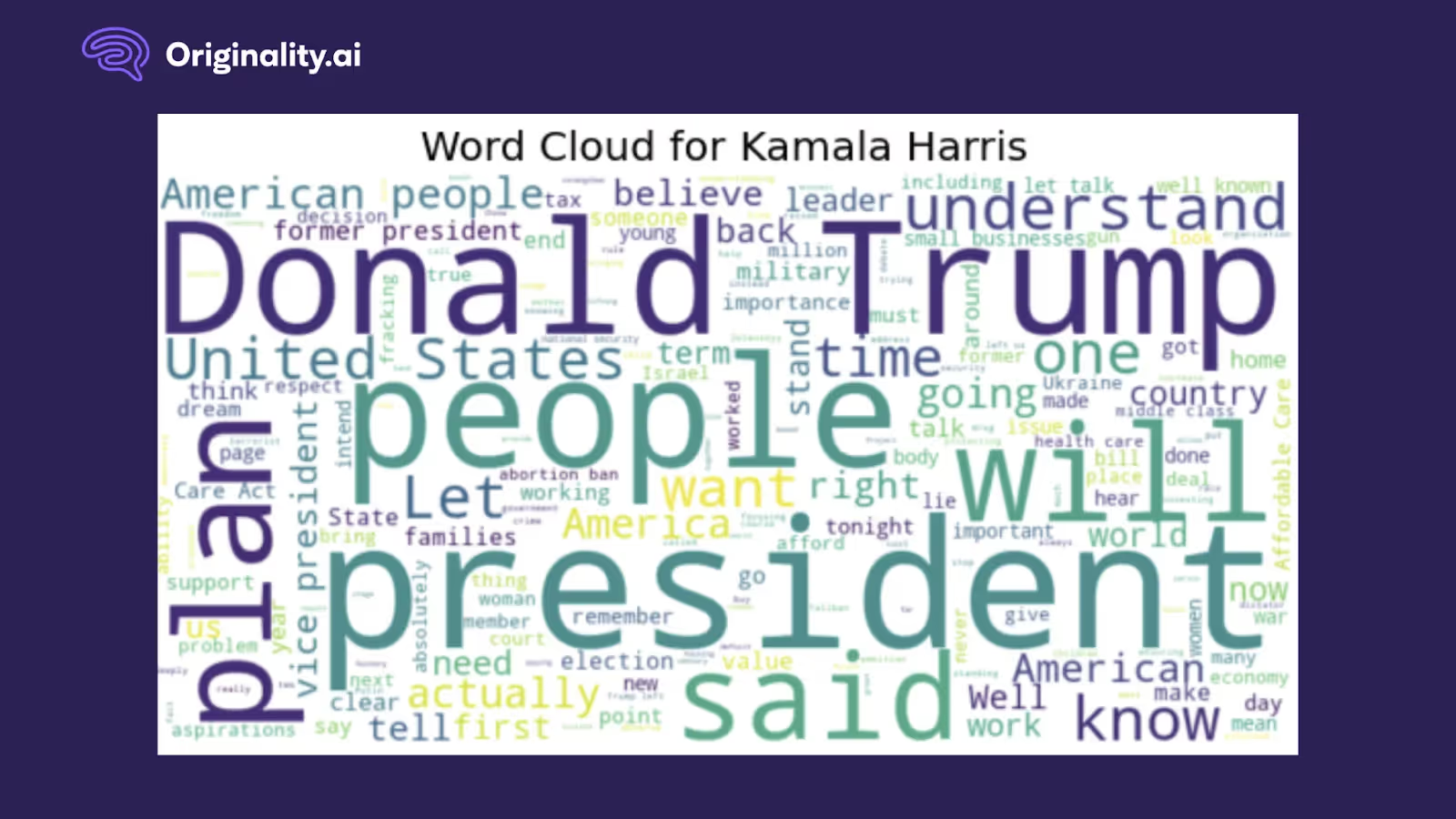
From Harris’s word cloud, people is also prominent, suggesting she also references the people of America frequently. Another word she uses frequently is Donald Trump, which is in reference to her constantly stating what she believes he will or won’t do if re-elected.
She also references the word “president” frequently, likely in reference to Trump the former president, or what she would do as your next president of the USA.
Overall, both candidates seem to focus heavily on "people" and the presidency, but their tone and focal points differ:
Trump’s cloud leans towards direct statements on actions and conditions, while Harris’s cloud reflects a focus on leadership, plans, and a response to Trump’s presidency.
While all this information is very insightful, it does leave one glaringly obvious question unanswered.
Why is readability actually important?
Well, in simple terms, the more readable the information, the more likely it is that the message will resonate with the majority of voters.
Final Thoughts
When it comes to conducting a political speech, nothing is more important than ensuring you strike the right tone for your audience.
After all, you could have the best policies in the world, if those policies are difficult to understand or comprehend, then your voter demographic will not connect with you or get inspired to vote.
That is why tracking things such as readability is so important, and nailing this aspect of the upcoming political speeches in such a tight race could mean a seat in the Oval Office.
Looking to check the readability of your own content?
If you’re curious about the readability of your own content, be sure to check out Originality.ai's readability checker.
Convention Speech Readability:
We analyzed the readability of political convention speeches using two metrics, Flesch-Kincaid Grade Level and Gunning Fog Index, which measure how complex the language is. We collected the speeches, calculated these scores, and visualized the results to compare the simplicity or complexity of the language over time.
Sentiment Analysis:
We analyzed the emotional tone of Kamala Harris' speeches (and potentially Donald Trump's) in 2024. Using TextBlob, we assigned sentiment scores (ranging from -1 for negative to 1 for positive) to each speech and plotted them on a graph. A trendline was added to show overall shifts in emotion over time.
Debate Analysis:
We compared Donald Trump and Kamala Harris’ debate speeches, analyzing readability and word frequency. Key metrics were calculated and visualized in bar charts, highlighting differences in language complexity and how often each candidate mentioned important election topics.
Word Clouds:
Word clouds were created for each candidate’s debate speech, showing the most frequently used words. Larger words appeared more often in their speeches, helping visualize their main talking points.
Data sources available upon request. Contact maddie@originality.ai for more information.

For those of you busying yourselves creating a business presentation, you might find using Google Slides the best method. Created by Google, this preferred presentation tool provides its users with a vast collection of excellent features to make sure presentations are engaging. In fact, this is the most popular presentation tool available.